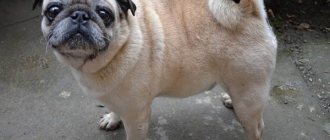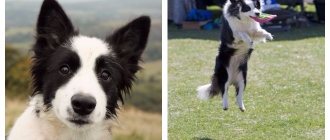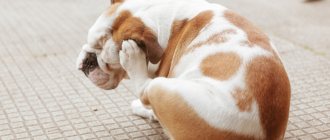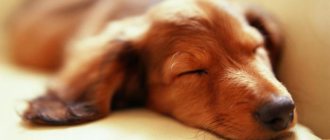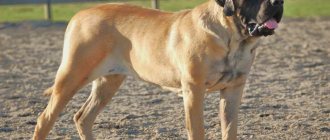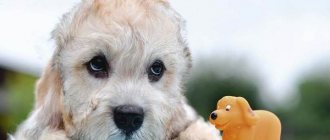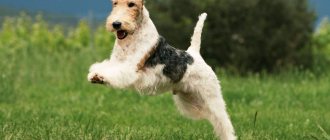Komondor
The biggest dog with dreadlocks. In the photo - this is a powerful shaggy giant, whose fur hangs to the ground in twisted cords, covering his ears and eyes. The Komondor is a type of Hungarian Shepherd. Its purpose is to help herd sheep. Looking at a photo of a dog with dreadlocks among a flock, you won’t immediately notice a four-legged shepherd in the photo. Dreadlocks are not the result of selection, they are a natural feature of the breed. The coat begins to curl during puppyhood, and the first pigtails appear at 6-8 months. It is unlikely that the ancient shepherds carefully combed their assistants, but they had to trim them along with the sheep. If this is not done, the cords get tangled and the animal loses its beauty. The unusual coat was not given to the Komondor by chance: such a fur coat retains heat perfectly, so it tolerates cold and temperature changes well, which is very important when serving on pastures in the highlands. The wool even covers the eyes, protecting them from the sun.
Character traits
The dog is completely independent. She will guard the object entrusted to her even in the absence of a person. This shepherd will not leave his post for a minute, even the males will not move after the bitch if they are on duty. But the Komondor develops such thoroughness over the years. This breed is also called the “eternal puppy”, because up to the age of three the dog is ready to frolic like a baby.
Excellent guarding qualities - this is why they love the mop dog. If the owner is in danger, she will attack the offender sharply and decisively. Dog breeders note the high level of intelligence of this breed. The Komondor is capable of making decisions on its own without human assistance. This affects training: the earlier socialization begins, the more adequate the animal will be in communicating with people. The Komondor perceives the family as an object entrusted to him for protection. He is extremely friendly with his owners, loves children, but is always wary with strangers and can be aggressive.
Pros and cons of the breed
Among the advantages of this breed are:
- Good security qualities.
- Strength, endurance.
- Kindness, calmness.
- Ease of training.
- Devotion.
- Positive attitude towards children.
But representatives of the Komondor breed also have some disadvantages. The disadvantages include the following features:
- Possible aggression towards strangers and other dogs.
- Stubbornness, desire for dominance.
- Difficulties in caring for the coat.
Bullets
Unlike the Komondor, the bullet has a more modest size. The height at the withers of a dog of this breed is 36-45 cm. The Puli is also considered a Hungarian Shepherd, although its homeland is China. Helping to herd livestock was the dog's main task, but over time it began to be used more as a companion or as a gun breed. The second name for the bullet is a floating dog. She received it for helping hunters pull game out of the water. But for its habits, the bullet could also be called flying: it perfectly jumps over the backs of sheep and covers a long distance in a jump.
Character traits
Like the Komondor, the Puli is extremely independent. She herself copes with a large herd: she understands where to move the animals, regulates the pace of movement of the flock, and quickly gathers the animals around her. At the same time, human society is important for the bullet: it quickly becomes attached to its owner and perceives him as the unconditional leader. There can be only one owner, the rest of the family members are “their own”, the dog shows respect to them, but not love. Those who find themselves among strangers must be careful with this breed: first they must earn the respect of the owners, and then the dog will accept the guest. The puli has an ambivalent attitude towards children: it can tolerate pranks, but cannot tolerate open bullying. Puli loves to be treated kindly, and if she is offended, the dog will withdraw into itself.
Maintenance and care
Komondors are extremely intelligent . Therefore, communication with them needs to be structured as if you were trying to teach something to a very small but smart child. It is imperative to diversify the training, otherwise the dog will begin to get bored and lazy. Bitches are easier to train than males.
These dogs cannot tolerate rude treatment and respond to it with aggression. But they respond to positive reinforcement with devotion and willingly fulfill any demands of their owners.
Long walks are required for Hungarian Shepherds , during which they can run well and warm up. It is better to keep Komondors in country houses with their own plot, where they always have the opportunity to be outside, sheltering from bad weather in a booth made for them.
Bergamasco
Another shepherd dog with dreadlocks, but this time from Italy. It got its name from the name of the province of Bergamo. For several hundred years she has been helping shepherds on the Alpine plains. This breed can live in the most difficult conditions, it does not freeze, and tolerates food deprivation well. The only thing that Bergamasco does not tolerate is space limitations. This dog needs space and the opportunity to run actively.
Character traits
Very obedient and easy to train. Her character, like that of all herding breeds, is independent, but at the same time, a leader is important for the Bergamasco. For the owner, she will become a real partner, partner and will never be the center of attention. Early socialization is important for this breed. Bergamasco accurately captures a person’s thoughts, so her family relationships with everyone develop individually. He loves children very much and prefers them to adults, because kids can be fun to play with. This breed is loyal to strangers, but until it feels threatened by a person. Then the Bergamasco will decisively defend its territory and its family.
Chinese Crested Dog.
Small and very active dogs. It can be either hairless (only a small amount of hair on the head, tail and limbs) or with soft hair all over the body. The homeland of this breed is China. The crested dog in China is still considered a symbol of the well-being of its owners. Such dogs are neither hunters nor guards, they are created for adoration. They get along well with children and are very attached to one owner. The Chinese Crested Dog is an ideal dog for those who want to train their dog to perform various tricks and commands. This dog can be taught to walk on its hind legs, jump over obstacles, climb stairs and much more. They really want to please their owners, so they will try to do everything they can and please their owner. Do you want to buy a friend - a Chinese Crested , the price of a puppy is from 2,500 to 20,000 rubles.
Features of pet care
- Wool. A dog with dreadlocks does not need to be combed. When the puppy's curls begin to get confused, they are separated by hand. The strands are separated by hand, and the older the dog, the less often this should be done. Wool grows throughout its life. The dog can be cut leaving dreadlocks 25 cm long.
- Bathing. For convenience, the dog is placed in the bathtub and watered from a flexible shower. You need a special shampoo for animals based on lanolin. You need to lather the cords very carefully, without circular movements, so as not to knock off the hair. At the end of washing, you need to thoroughly rinse the dreadlocks and squeeze them out with your hands, like a mop. In order for the braids to take on their natural shape, it is better to leave them slightly damp and let them dry on their own.
- The animal's ears and paws must be carefully examined. Due to the thick fur, wounds or parasites may not be noticed. It is recommended to cut the fur cords on the paws and ears.
History of the breed
There are many different opinions about the history of the breed, each of which has both opponents and supporters. We'll look at the most popular ones.
Komondors were brought to Hungary by the Cumans (in European and Byzantine sources - Cumans), a Turkic-speaking people who settled on its territory between the 12th and 13th centuries. The name of the breed comes from kuman-dor and means “Polovtsian dog.”
The breed comes from the dogs of Tibet, came from Asia along with the Polovtsian tribes, whose homeland was in the area of the Yellow River.
At the end of the 10th century, they themselves began to be displaced by the advancing Mongol tribes, forcing them to move west. Fleeing from the Mongols, they reached the borders of Hungary in the 12th century, where they settled in 1239 under the leadership of Khan Kotyan Sutoevich.
On this territory there are burials of Polovtsy, in which their dogs are also buried. The name of the breed first appears in the book “The History of King Astgias” by Peter Kokony written in 1544. Later, in 1673, Jan Amos Comenius mentions them in his works.
Today Komondors are very popular and common in Hungary, primarily as herding dogs. This is probably not their homeland, but they have lived here since at least the 13th century and have always been valued for their working qualities. Most breeders only tried to improve them and create the perfect herding dog.
These dogs were specially made white so that, on the one hand, they would camouflage among the sheep, and on the other, they would be easily distinguishable from a wolf.
However, until the 20th century, the breed was practically unknown outside its homeland. In 1933, Komondors were first brought to the United States by Hungarian immigrants. In the same year they were recognized by the American Kennel Club (AKC), but the first club was created only in 1967. But the United Kennel Club (UKC) recognized the breed only in 1983.
It was the American population that largely saved the breed, since the Second World War was devastating for it. The dogs served in the army and many died during the fighting. Those who remained in their homeland were killed by hunger and need during the war.
Between 1945 and 1962, no more than 1 thousand dogs were registered in Hungary. Fortunately, some of them lived in agricultural areas not affected by the fighting.
Today, Hungarian Shepherds remain a fairly rare breed; it is believed that 2000–3000 individuals live in the United States and 5000–7000 in Hungary.
The main population lives in these countries, in the rest there are no more than 10,000 individuals. The reasons why it is not so popular abroad are its protective nature and high maintenance requirements.
This breed is similar to the Bergamasco Shepherd, but they are not related and even their cord formation is different.
Description of the breed
The Commander has one of the most unique and memorable looks in the dog world. These are very large dogs, and also pure white in color. And their fur forms long cords, reminiscent of dreadlocks.
Hungarian breeders say that if a dog is not large, then it is not a Komondor. Males can reach more than 80 cm at the withers, females 65-70 cm. However, there are no restrictions on the maximum; the taller the dog, the more expensive it is.
With this height, Hungarian Shepherds weigh relatively little, males 50–60 kg, females 40–50. For example, similar-sized English Mastiffs weigh 80-110 kg.
The dog's head is hidden under long cords and fur, underneath which lies a short muzzle with a very strong bite force. The dog's eyes should be dark brown or almond. The ears are drooping and v-shaped.
The main feature of the breed is its wool. It should be white, although not always pure white, sometimes it is darker due to dirt, since the dog is rarely washed.
Some puppies have cream-colored spots that fade with age. Ideal dogs have a bluish-gray skin color, although some may exhibit an undesirable shade of pink.
The coat is very long, slightly shorter on the back, neck and face. Like most other breeds, puppies are born with a soft, curly coat; as they grow older, the coat lengthens and begins to curl, gradually forming cords.
The cords reach 20–27 cm in length and grow slowly. Around two years of age, they are finally formed, and the required length is reached only in the 5th year of life. However, by the age of two, the dog should already have formed the main cords that cover the entire body.
For proper formation, they need to be braided, otherwise the dog will turn into one large, matted ball of hair. But they shed minimally, the largest shedding occurs in the puppy when the puppy fluff falls out.
Traditionally, such hair protected the dog from the bites of wolves, which could not bite through it. It takes two and a half days for it to dry completely after washing.
The tail is carried low, never high. At first glance, it seems that the dog does not have a tail at all, since it is completely hidden under the cords.
